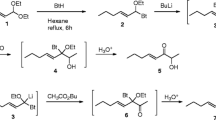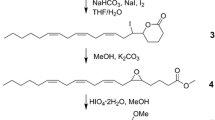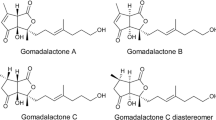Abstract
Pentane extracts of matureDrosophila melanogaster males substantially increased the attractiveness of food odors to both males and females in a wind-tunnel olfactometer. Extracts of females caused no such increase. An active component of the extract was isolated and identified as (Z)-11-octadecenyl acetate (cis-vaccenyl acetate, cVA), and synthetic cVA was active in bioassay. Hydrolysis of the ester linkage or movement of the double bond to the 9 position destroyed the activity. Mature virgin males released cVA into their feeding vials, and amounts of synthetic CVA equal to that released per male caused significant bioassay responses. Females, which were known to receive cVA from males during copulation, were found to emit relatively large amounts of the ester into their feeding vials within 6 hr after mating. cVA had been demonstrated previously to be a close-range pheromone inD. melanogaster, discouraging males from courting other males or recently mated females; it now appears to have a longer-range function as well.
Similar content being viewed by others
References
Antony, C., andJallon, J.-M. 1982. The chemical basis for sex recognition inDrosophila melanogaster.J. Insect Physiol. 28:873–880.
Bartelt, R.J., andJackson, L.L. 1984. Hydrocarbon component of theDrosophila virilis (Diptera: Drosophilidae) aggregation pheromone: (Z)-10-Heneicosene.Ann. Entomol. Soc. Am. 77:364–371.
Blum, M.S. 1977. Behavioral responses of Hymenoptera to pheromones and allomones, pp. 149–167, in. H.H. Shorey and J.J. McKelvey, Jr. (eds.). Chemical Control of Insect Behavior: Theory and Application. John Wiley, New York.
Brieger, G., andButterworth, G.M. 1970.Drosophila melanogaster: Identity of male lipid in reproductive system.Science 167:1262.
Butterworth, F.M. 1969. Lipids ofDrosophila: A newly detected lipid in the male.Science 163:1356–1357.
Fogleman, J.C. 1982. The role of volatiles in the ecology of catophilicDrosophila, pp. 191–206, in. J.S.F. Barker and W.T. Starmer (eds.). Ecological Genetics and Evolution: The Cactus-Yeast Drosophila Model System. Academic Press, Sydney, Australia.
Hutner, S.H., Kaplan, H.M., andEnzmann, E.V. 1937. Chemicals attractingDrosophila.Am. Nat. 71:575–581.
Jallon, J.-M. 1984. A few chemical words exchanged byDrosophila during courtship and mating.Behav. Genet. 14:441–477.
Jallon, J.-M., Antony, C., andBenamar, O. 1981. Un anti-aphrodisiaque produit par les mâles deDrosophila melanogaster et transferé aux femelles lors de la copulation.C.R. Acad. Sci. Paris 292:1147–1149.
Kellogg, F.E., Frizel, D.E., andWright, R.H. 1962. The olfactory guidance of flying insects: IV.Drosophila. Can. Entomol. 94:884–888.
Mane, S.D., Tompkins, L., andRichmond, R.C. 1983. Male esterase 6 catalyzes the synthesis of a sex pheromone inDrosophila melanogaster females.Science 222:419–421.
Rodrigues, V., andSiddiqi, O. 1978. Genetic analysis of chemosensory pathway.Proc. Indian Acad. Sci. 87B:147–160.
Spieth, H.T. 1974. Courtship behavior inDrosophila.Annu. Rev. Entomol. 19:385–405.
Tompkins, L., andHall, J.C. 1981a. The different effects on courtship of volatile compounds from mated and virginDrosophila females.J. Insect Physiol. 27:17–21.
Tompkins, L., andHall, J.C. 1981b.Drosophila males produce a pheromone which inhibits courtship.Z. Naturforsch. 36C:694–696.
Yates, F. 1940. The recovery of interblock information in balanced incomplete block designs.Ann. Eugen. 10:317–325.
Author information
Authors and Affiliations
Rights and permissions
About this article
Cite this article
Bartelt, R.J., Schaner, A.M. & Jackson, L.L. cis-Vaccenyl acetate as an aggregation pheromone inDrosophila melanogaster . J Chem Ecol 11, 1747–1756 (1985). https://doi.org/10.1007/BF01012124
Received:
Accepted:
Issue Date:
DOI: https://doi.org/10.1007/BF01012124




